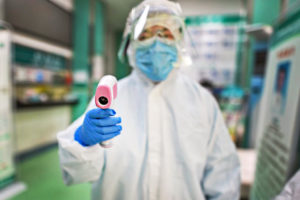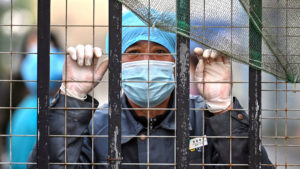Last autumn, American intelligence agencies reported to the White House that they remain divided on whether the pandemic started naturally or was the result of a lab accident. “All agencies assess that two hypotheses are plausible: natural exposure to an infected animal and a laboratory-associated incident,” the report concluded. At least among foreign policy experts, the lab-leak theory is no longer dismissed out of hand.
But this virus has now killed over 6,000,000 people across the planet, and if lab research caused it, imagine what it would do to the entire field of virology. Money would be withdrawn and careers shuttered; it would be devastating. Small wonder, perhaps, that at the beginning of the pandemic anyone discussing a possible lab accident was swiftly dismissed by the science community as a “conspiracy theorist”. Donald Trump’s own opinion was particularly helpful on this matter.
Two essays in particular had a particularly powerful effect on the narrative. Placed in The Lancet and Emerging Microbes & Infections, both of them debunked the lab-leak theory. Their publication initially shut down any debate about the pandemic origin; but both reports were subsequently exposed as being rather compromised. The essay in The Lancet had been orchestrated behind the scenes by Peter Daszak, who runs a nonprofit called EcoHealth Alliance, that directly funds research at the Wuhan Institute of Virology. Daszak’s obvious conflicts of interest forced The Lancet to shut down their own investigation of the pandemic’s origin. At Emerging Microbes & Infections, the essay authors were caught passing the draft for approval to a scientist who Daszak funds at the Wuhan Institute of Virology.
Since that strategy has been wearing thin, a new tactic is being deployed: drafts of useful studies are being published online and then rushed into public discussion with friendly science writers.
To push back against public perception that their Wuhan colleagues could have made a mistake, researchers have been allaying themselves with science writers, who often regurgitate whatever researchers say or publish. “Science reporters, unlike political reporters, have little innate skepticism of their sources’ motives,” wrote science writer, Nicholas Wade, in an essay last year, that detailed how the pandemic could have started in a Wuhan lab. “Most see their role largely as purveying the wisdom of scientists to the unwashed masses.”
This lack of cautious scepticism now extends to preprints — the drafts of studies that scientists post online before they have been vetted by journal editors and peer reviewers. Peer review can be laborious and time-consuming, sometimes lasting weeks or months, and is far from perfect. But when a scientist wants to plant an opinion in the public mindset, publishing a preprint can serve this purpose; it helps if science writers are willing to ignore the need for expert vetting of the paper, before rushing the draft study into headlines. Such is the thirst for new stories about Covid-19 that this is now proving the case. A perfect example has just been published.
A week ago, Chinese government scientists posted a preprint online that analysed swabs sampled early in the pandemic at a market in Wuhan to detect the Covid-19 virus. The following day, a coterie of Western scientists rushed to publish two preprints of their own, analysing much of the same evidence. The Chinese preprint concluded that the market was the focus of either the pandemic’s origin or a spreading event where someone outside the market brought it in. Western scientists, however, argued that the same evidence showed the pandemic began in the market from an infected animal.
The Western report and its emphasis on an infected animal passing the virus to someone in the market as being the origin of the pandemic became the dominant narrative for New York Times science writers. Their story ran soon after.
“BREAKING NEWS: Two major scientific studies point to a market in Wuhan, China — not a lab in the same city — as the birthplace of the coronavirus pandemic,” read an early version of a story filed by New York Times reporters Carl Zimmer and Benjamin Mueller. The opening failed to note that the “major scientific studies” were only preprints that had not been vetted by experts.
“When you look at all of the evidence together, it’s an extraordinarily clear picture that the pandemic started at the Huanan market,” the Times quoted Michael Worobey, a co-author of both studies and a researcher at the University of Arizona. In an essay he published last November in Science Magazine, Worobey also argued that the pandemic began in the Wuhan market. However, this conclusion was later criticised as unscientific by Liang Wannian, a Beijing public health official who has led the country’s Covid-19 response.
The New York Times article does give brief mention to the Chinese preprint, which noted that no infected animals have been found, for example, and wrote that an infected human could have brought the virus into the market. “Thus, the market might have acted as an amplifier due to the high number of visitors every day,” the Chinese scientists report, “causing many initially identified infection clusters in the early stage of the outbreak as indicated in the Report of WHO-convened global study of origins of SARS-CoV-2.”
The Western scientists, in contrast concluded, “Together, these analyses provide dispositive evidence for the emergence of SARS-CoV-2 via the live wildlife trade and identify the Huanan market as the unambiguous epicenter of the Covid-19 pandemic.” And this is what the New York Times reported, even though both sets of scientists drew polar opposite conclusions based on mostly similar data.
This did not escape the notice of Alina Chan, a Scientific Advisor at the Broad Institute of MIT and Harvard, and co-author of VIRAL: the search for the origin of Covid-19. Interviewed by The Hill TV, Chan pointed out that the Western scientists did not find the “incontrovertible” proof that was claimed — and Chinese researchers concluded the opposite. “We are just repeating what happened in 2020, which is a bunch of scientists and reporters rushing to print headlines about the origins of COVID19.” Chan said.
Politically, as Matt Yglesias noted, this is important. The New York Times report shows that “once again, I think the press is getting way ahead of its skis,” he wrote. “But we should keep in mind that the virologists publishing papers downplaying the possibility of a lab leak are not disinterested parties in this. The political context is a debate about regulating virus labs, and it’s hardly shocking that a large segment of the virus lab community doesn’t like that idea.”
This wasn’t the only omission by the Times: it also failed to report on a note buried at the bottom of both Western studies, where several scientists — including Michael Worobey and Kristian Andersen of the Scripps Research Institute — disclosed that they have received consulting fees or have been compensated for expert testimony on the Covid-19 pandemic. Neither scientist responded to questions from me about the nature of this consulting or expert testimony, or who it is for.
“Journalists owe it to their readers to help them understand both the strengths and limitations of scientific research – especially when the paper is a pre-print and has not been through peer review,” says Alison Young, who spent many years as an investigative reporter uncovering problems at labs studying dangerous pathogens and is now the Curtis B. Hurley Chair in Public Affairs Reporting at the University of Missouri School of Journalism. “In covering this kind of research, especially on the polarized topic of Covid’s origin, it is critical for reporters to note where conclusions are based in part on speculation,” she added.
Worryingly, this isn’t the first instance of uncritical reporting on preprints at the New York Times science desk. Last October, the Times’s Carl Zimmer reported on a preprint that discovered viruses most closely related to Covid-19 in Laos, far, far away from Wuhan. Zimmer quoted Worobey saying that the preprint finding these viruses in Laos “puts to bed” the idea that the Covid-19 virus could have come from a Wuhan lab. However, months prior to this Times article, researchers at the Wuhan Institute of Virology had already reported in a scientific paper that they had been collecting viruses from Laos since at least 2006.
Before this unfortunate incident, Zimmer wrote an article for Time Magazine praising research by China’s controversial virologist Shi Zhengli, and described claims that the pandemic could have started at the Wuhan Institute of Virology “not just baseless but dangerous”.
“It does look like the science desk at the New York Times has a position on the subject of the lab leak,” says Richard Ebright, professor of molecular biology at Rutgers University in New Jersey and a biosafety expert. And few answers explaining how the pandemic started will be found in science journals; Ebright thinks the world needs forensic investigators and congressional committees to get to the bottom of what caused so many deaths.
Getting to the bottom of this is important because as we’ve seen over the course of the pandemic, science can be used to present a contrived picture of reality. It can be co-opted by politics and even used as an instrument of state propaganda. “So long as this is kept within science, all other evidence is excluded,” says Ebright. “And that’s what some science journalists and scientists want to do.” As we now know, not all parties are disinterested ones.
Neither Carl Zimmer nor editor Virginia Hughes responded for comment.
Disclaimer
Some of the posts we share are controversial and we do not necessarily agree with them in the whole extend. Sometimes we agree with the content or part of it but we do not agree with the narration or language. Nevertheless we find them somehow interesting, valuable and/or informative or we share them, because we strongly believe in freedom of speech, free press and journalism. We strongly encourage you to have a critical approach to all the content, do your own research and analysis to build your own opinion.
We would be glad to have your feedback.
Source: UnHerd Read the original article here: https://unherd.com




